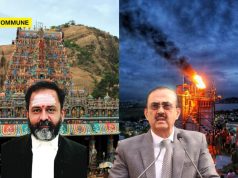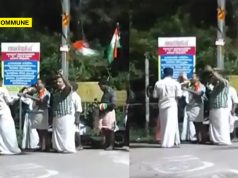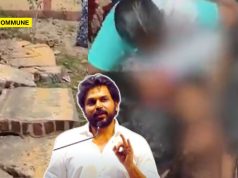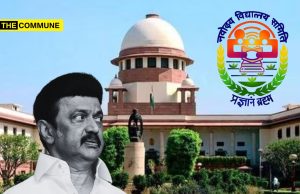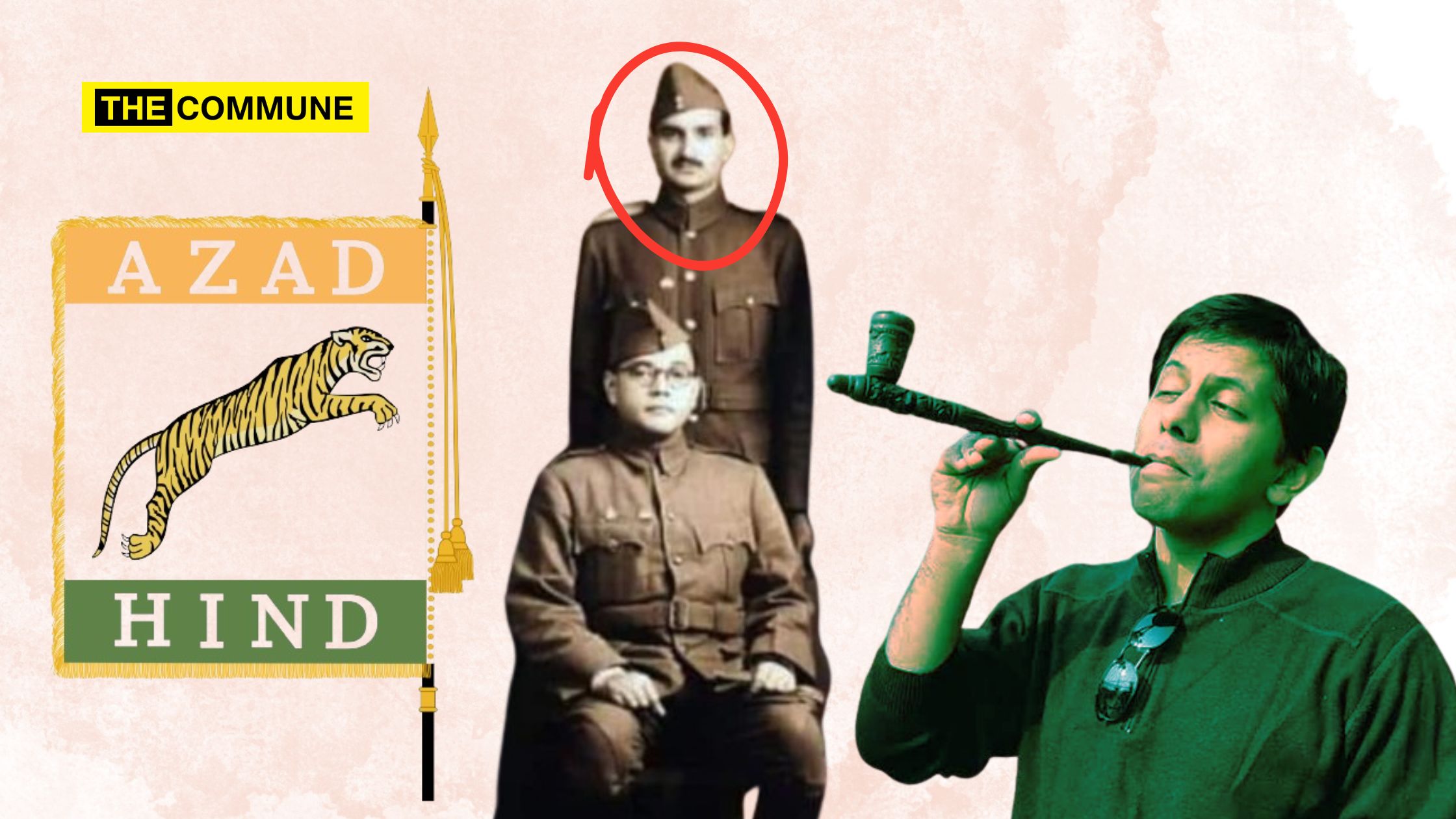
YouTuber Akash Banerjee, known for his channel The DeshBhakt, is accused of spreading misleading narratives about Netaji Subhas Chandra Bose, the Azad Hind Fauj and the national anthem. In a video, he inaccurately linked Netaji’s rejection of a temple event to his secular views against Hindutva. He also suggested that “Tipu Sultan’s rebellion” inspired the Fauj’s tiger emblem.
The YouTuber also claimed that Bose introduced Gurudev Rabindranath Tagore‘s “Bharoto Bhagyo Bidhata” as the Azad Hind Fauj’s anthem. These distortions are part of a broader pattern of leftist narratives that aim to present Bose as a secular figure opposed to Hindutva.
He went a step ahead to contort the reality of Zaman Kiyani, Netaji’s close aide who betrayed his ideals by aligning with Pakistan’s anti-India efforts after partition. Banerjee desperately promotes Kiyani’s value for Netaji, perhaps to whitewash the Hindu-hating realities of a man who orchestrated the 1948 Kashmir raid for Liaqat Ali Khan.
“The Deshbhakt” has consistently peddled fake narratives. It is concerning that his 4.93 million subscribers are falling for his propaganda.
Akash Banerjee’s video on Netaji
In a video released about six months ago, he discussed how Netaji was anti-Hindutva. His narrative also includes a fib on how the national anthem came into being.
He starts with some random, seemingly unconnected tidbit of information on Netaji.
“1943, Singapore. World War II was at its peak. Japanese troops had driven British out of Singapore. Netaji Subhash Chandra Bose’s Azad Hind army was present in Singapore. They declared war on British rule. Netaji Bose’s Azad Hind, provisional government of free India was established. Chettiars, a Tamil Hindu trading caste from Singapore invited Netaji to a grand function at a temple, for a fundraising event for the provisional government. The Chettiar community were already the main financers. So, the money and funding used to come from here. Despite this, Netaji Bose rejected the invitation.
He said that he will not go to the temple where caste and religion are discriminated against. Netaji believed that religion and matters of state do not mix and that is why he did not want to give a religious angle. The priests clarified that this event is not for any religion or caste. It is a nationalist event. In the end, Netaji accepted the invitation and entered the temple.
Here is where the lying gets worse. Akash Banerjee talks about Netaji being with Zaman Kiyani
But interestingly, he was with his two close friends, who were senior officers in his army. Abid Hasan and Zaman Kiyani. Scholars believe that there was a clear message that a provisional government will have religious unity, and no one will be seen from any lens.”
Dear Akash Banerjee,
Why tell half story to guard your fairy tale of secularism?
Yes, while visiting a temple, Netaji took his trusted commander Zaman Kiyani with him
But Zaman Kiyani later betrayed India and led Pakistan's attack on Kashmir in 1948
History is painful pic.twitter.com/3w71lAvVWD
— Abhishek (@AbhishBanerj) August 16, 2024
Indian National Anthem
Then, “the Deshbhakt” goes on to fib about the Indian national anthem written by Rabindranath Tagore.
Banerjee says that the Congress sang Vande Mataram as an anthem. Since Vande Mataram sounded like a song praising a goddess, it did not “fit a nationalist gathering”, as quoted by Bose.
Tipu Sultan’s “rebellion” inspired Bose?
The content creator also claimed that Azad Hind Fauj members’ army uniform had a patch with an emblem of a jumping tiger in the middle of the Tiranga, “remembering Tipu Sultan’s rebellion”. This is a false claim. There is no proof that Bose was a “fan” of Tipu Sultan and was inspired by him to use the springing tiger as an emblem.
False claim that Netaji’s insignia was inspired by Tipu.
It is pity that Netaji’s family know least about Netaji. https://t.co/wx6apwqcvM
— Aabhas Maldahiyar 🇮🇳 (@Aabhas24) February 14, 2024
Here is some clarification on the so-called secular icon Tipu Sultan. He was the most barbaric of Islamic tyrants, who took pride in inflicting unspeakable cruelties on Hindus.
Tipu Sultan waged a jihad against Hindus, especially in the Malabar region and Kodagu, where his forces destroyed numerous villages, forcibly converted thousands, and depopulated the area. His invasion led to significant loss of life, destruction of temples, and long-lasting damage to Hindu communities, with survivors fleeing or being forced into conversion. The impact of his conquests is still felt today, as seen in the continued absence of Deepavali celebrations among the Mandyam Iyengars and the remnants of temple destruction.
Azad Hind Fauj’s anthem
Then he comes back to how Bose inaugurated the German Indian Society in Hamburg on 11 September 1942, where he introduced a 55-second version of Tagore’s Bharoto Bhagyo Bidhata. The Chamber Orchestra of Radio Hamburg performed it.
“Since it was written in difficult Bangla, Netaji asked Captain Abid Hasan to translate it into simple Hindustani. Captain Abid Hasan translated the song. This became the national anthem of the Azad Hind Fauj.”
Then he peddles his narrative of Bhakti, bigotry, secularism, and all that jazz.
It is noteworthy that the lies about the springing tiger, the INA’s motto in Urdu, and Netaji speaking in “eclectic Hindustani” has been peddled by all the leftist mouthpieces, including Akash Banerjee, the NewsClick, The Wire etc.
Who Was Zaman Kiyani?
Now let’s take a look at Netaji’s close aides, who these leftists have been praising, especially Zaman Kiyani.
Zaman Kiyani, also known as Zaman Kiani, was a senior officer in the INA. He was originally from the British Indian Army and later joined the INA under Bose’s leadership.
Kiyani was a trusted commander in the INA and played a key role in the INA’s military campaigns against the British forces in India. His military experience was valuable to Bose, who relied on Kiyani to execute operations and maintain discipline within the ranks. After the end of World War II and the disbandment of the INA, Kiyani’s fate diverged from that of many INA members.
Interestingly, after the partition, Zaman Kiani returned to Rawalpindi in 1947. In September of that year, Pakistani PM Liaquat Ali Khan and Punjabi Minister Shaukat Hayat Khan appointed him to lead the southern wing of Pakistan’s efforts to challenge the rule of the Maharaja of Jammu and Kashmir. Kiani established the General Headquarters, known as GHQ Azad, in Gujrat City, in the Pakistani province of Punjab, where he organized and directed operations along the Kashmir border. His forces coordinated raiding activities and supported the Kashmiri ‘rebels’ in Poonch, which resulted in the formation of PoK.
(1) Maj Gen Mohammed Zaman Kiani
– Commander INA's 1st Division
– Chose Pakistan in 1947
– 1947-48 War – Established GHQ Azad in southern Kashmir for Pakistan and organized the Poonch rebellion
– 20,000 Hindus & Sikhs were massacred under his watchpic.twitter.com/ZUOPJx7Yni pic.twitter.com/ZM7bQJpc0p— VatsRohit (@KesariDhwaj) August 16, 2024
Maj Gen Anil Chandra Chatterjee, Maj Gen Mohammed Zaman Kiani and Col Habibur Rahman with Netaji Subhash Chandra Bose.
On October 1943, Netaji read his famous Proclamation of the Provisional Government of Azad Hind in which he distributed cabinet roles, assigning finance to Lt… pic.twitter.com/1mTszm9Gkv
— 𝐒𝐓𝐀𝐕𝐊𝐀 (@Maverickmusafir) August 15, 2023
In Conclusion
Had Bose been alive at the time of partition, would he not have felt backstabbed by the same Kiani whom he thought was his loyalist and close aide?
Banerjee constantly peddled lies about the INA to establish that Bose was inherently very secular. The false propaganda that Netaji denounced “Hindutva” is a clear sign of trying to brainwash the next generation. It’s important to critically evaluate such claims, especially when they attempt to simplify or distort complex historical realities.
Subscribe to our Telegram, WhatsApp, and Instagram channels and get the best stories of the day delivered to you personally.

